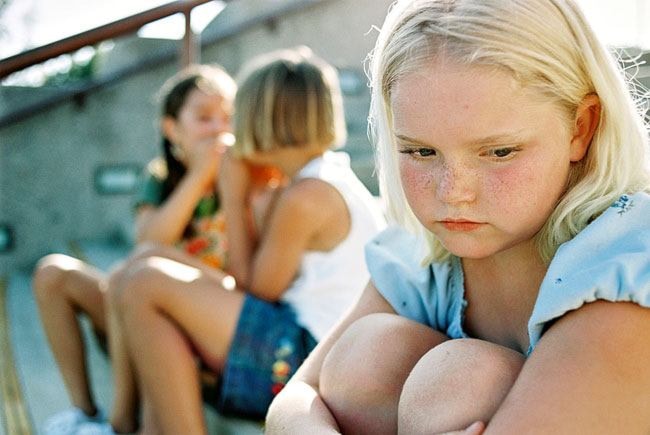Christine Klaassen-St. Pierre makes her students cry.
And F. H. Collins Secondary School is healthier for it.
The school’s vice principal is wearing a tight red T-shirt with “Do an act of change everyday” scrawled across it in chunky, graffiti-style lettering.
It’s a motto Klaassen-St. Pierre lives by.
But it took some childhood bullying and more than two decades of teaching for her to figure that out.
It all started in Grade 3.
She was overweight and she suffered for it.
“I got teased,” she said.
Then she sprouted up, lost weight and ended up on the other side of the bullying, as a bystander.
“I saw others getting teased but didn’t want to speak up because I didn’t want to become a target,” she said.
As a teacher, it became easier for her to speak up, but school bullying continued.
It wasn’t until six years ago, when she went back to school for a master’s degree, focused on building peace at school, that Klaassen-St. Pierre had an epiphany.
Now it’s not the bully or the victim that she targets, it’s the bystander.
“You can make a huge difference working with the bystander,” she said.
“They are the most powerful.
“Over 50 per cent of the time, bullying will stop if someone steps in and says something.”
And this is what’s happening at F.H. Collins more and more.
When Klaassen-St. Pierre started there, F.H. was known as the “ghetto school,” she said.
Now eight years later, fights, suspensions, substance abuse and vandalism are down.
And she is seeing more and more students transferring to her school, including lesbian, gay and transgender teens who find the school “a safe place to be,” she said.
The school owes much if its transformation to a video she came across just after completing her master’s.
In it, a mismatched group of students and teachers are seen participating in Challenge Day, an initiative started by two school counsellors in California who ended up overseeing the Columbine school rehabilitation after the horrific Colorado shooting.
It urges kids to be the change they want to see in the world and one activity in particular stood out.
All the participants stood on one side of the gym, behind a line on the floor. Across the gym there was another line.
Then the organizers started calling out scenarios like: “If you’ve ever been teased for body shape, please cross the line,” or “If you’ve ever been teased for wearing glasses ... or for sexual preference.”
Eventually everyone ended up on the other side of the gym, including teachers, bullies and the bullied.
Many also ended up in tears.
After watching the video the first time, Klaassen-St. Pierre didn’t believe it.
“I thought it was scripted,” she said.
So when she found out a Challenge Day was being held at an Alberta school, she went to see for herself.
“And the same thing happened,” she said.
The crossing the gym exercise was only one small part of it.
A cross section of students and staff ended up in groups with peers they’d never have associated with, sharing their innermost details. Sometimes the bullies and the bullied even ended up together.
What’s learned during this one day can last for years, if not for life. And Klaassen-St. Pierre has used Challenge Day to transform not only F.H. Collins but other schools in the territory and the larger community.
Inspired by the change the day had made at local schools, a group of adults created the Yukon Circle of Change, initiating pay-it-forward events such as buying a coffee for the next person in line, starting a chain that has been known to last all day.
Local cafes have reported more than 800 coffees paid forward in one day in Whitehorse, said Klaassen-St. Pierre.
But the big focus for her remains bullying.
“Bullying is not just in schools,” she said. “It’s in families and workplaces. And it’s also online.”
That’s why she doesn’t buy into the “zero tolerance” rhetoric.
Kicking a bully out of school isn’t going to solve the problem, she said. “It’s more complex than that.”
People who hurt others have usually been hurt themselves. “And bullies still have a right to education,” she said.
So kicking them out of school doesn’t make a lot of sense to her.
Instead, she focuses on the power of the bystanders. When bullies do need discipline, they’re given in-school suspensions where teachers go over their lessons with the student alone, and breaks and lunch hours are also spent alone.
“They hate it more than being at home,” she said with a grin.
As Klaassen-St. Pierre was doing this interview on Tuesday, a student dropped by to talk about the Gay/Straight Alliance meeting at lunch.
This wouldn’t have happened a decade ago.
And on Tuesday afternoon Klaassen-St. Pierre was set to hold a restorative circle with two girls who have been butting heads since elementary school.
“Acknowledging the harm you’ve caused is pretty powerful,” she said.
That’s where the tears come in.
Creating change comes down to three simple actions - notice, choose and act, she said.
“Notice if people are being unfair or unkind. Choose if you’re going to accept it or not. And act on it.”
On Saturday, Klaassen-St. Pierre is sharing her expertise with local women at the Yukon Advisory Council of Women’s Issues annual forum at the Gold Rush Inn in Whitehorse.
The theme this year is “create the change you want to see.”
All women are welcome and registration is free.
For more information call 667-3030 or 1 (800) 661-0408 ex. 3030.
Contact Genesee Keevil at
gkeevil@yukon-news.com
